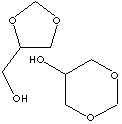|
GLYCEROL
FORMAL
|
||
|
PRODUCT IDENTIFICATION |
||
| CAS NO. | 4740-78-7, 5464-28-8 |
|
| EINECS NO. | 225-248-9, 226-758-4 | |
| FORMULA | C4H8O3 | |
| MOL WT. | 104.11 | |
|
H.S. CODE |
2932.90 | |
| TOXICITY | Oral rat LD50: 8.6 ml/kg | |
| SYNONYMS | Methylidinoglycerol; Sericosol N; | |
| 1,3-Dioxolane-4-methanol; 1,2-(Methylidene)glycerol; Glycerin formal; mixture of 5-hydroxy-1,3-dioxane and 4-hydroxymethyl-1,3-dioxolane; | ||
|
SMILES |
|
|
|
CLASSIFICATION |
||
|
PHYSICAL AND CHEMICAL PROPERTIES |
||
| PHYSICAL STATE | Clear colourless liquid | |
| MELTING POINT |
|
|
| BOILING POINT | 193 - 195 C (Decomposes) | |
| SPECIFIC GRAVITY | 1.21 - 1.22 | |
| SOLUBILITY IN WATER | miscible | |
| PH | 4.0 - 7.0 (10 % solution) | |
| AUTOIGNITION | 400 C | |
| NFPA RATINGS | Health: 1; Flammability: 1; Reactivity: 0 | |
|
REFRACTIVE INDEX |
1.451 | |
| FLASH POINT |
97 C |
|
| STABILITY | Stable under ordinary conditions | |
|
APPLICATIONS |
||
| Glycerol Formal is the mixture of 5-hydroxy-1,3-dioxane and 4-hydroxymethyl-1,3- dioxolane (60:40) which are cyclic ether compounds having 2 oxygen atoms in the ring structure and substituted by alcohol group. Glycerol Formal is a low odour and low toxic solvent for a wide variety of applications in pharmaceutical and cosmetics industry including anti-parasite veterinary injectibles, intramuscular injections, sulphadiazine and trimethoprin preparations. It is used as a slowly evaporating solvent in insecticide delivery systems. It is used in formulation of water-based inks. | ||
| SALES SPECIFICATION | ||
|
APPEARANCE |
Clear colourless liquid | |
|
CONTENT |
99.0% min |
|
| FORMALDEHYDE | 0.1% max | |
| PEROXIDE | 15ppm max | |
| WATER | 0.5% max | |
| COLOUR (HAZEN) | 30 max | |
| HEAVY METALS | 20ppm max | |
| TRANSPORTATION | ||
| PACKING | 25kgs in Drum | |
| HAZARD CLASS | 3 | |
| UN NO. | 1993 | |
| GENERAL DESCRIPTION OF ETHER | ||
| Ether is any of a number of organic compounds characterized by an oxygen atom
joined with single bonds by two carbon atoms that are part of hydrocarbon
groups. The general formula is R-O-R', where R and R' are alkyl or aromatic
groups. Ethers are formed by the condensation of two alcohols by heating with
sulfuric acid; the reaction is one of dehydration. Ethers can be prepared from
alkyl halide reacted with metallic alkoxide (called Williamson synthesis).
Ethers are similar to alcohols but are generally less dense, less soluble in
water, and have lower boiling points. They are relatively unreactive, which
makes them valuable solvents. But ethers will be
cleaved at high temperatures by concentrated hydrogen halides. Ethers have relatively low boiling point
compare to alkanes as they don't form hydrogen bonds each other. Ethers are more
lipophilic than esters [R-C(=O)-O-R']or amides [RCO-NH2]. Ethers are widely used as solvents for various organic reactions because they
are relatively the least reactive among common organic compounds except alkanes
and fluorocarbons. The common reaction of ethers is cleavage of the C–O bond by
strong acids either in linear chain or cyclic structure. Ethers in which oxygen
is bonded to primary and secondary alkyl groups can form peroxide compounds in
the presence of gaseous oxygen due to two unpaired electrons in oxygen. Ethers can act as
Lewis bases in chemical reactions. Commonly, ethers are
named simply in listing the alkyl groups in alphabetical order or alkane order
such as ethyl methyl ether or methyl ethyl ether, which is methoxyethane in
IUPAC nomenclature ( the formula of "alkoxyalkane" ). When ether is a
parts of complex molecule or aromatic derivatives, it is described as an alkoxy
substituent such as methoxybenzene ( trivial name is anisole). The methoxy
prefix indicates the function methyl group joined by single bonds to an oxygen atom,
with the general formula -O-CH3. Cyclic ethers
have ring structure where the oxygen has become part of the ring. The term of
epoxide indicate three membered cyclic ether (also called oxirane) in which an
oxygen atom is joined to each of two carbon atoms that are already bonded to
each other; four
membered cyclic ether is called oxetane; five membered cyclic ether, furan (or
oxolane); six membered cyclic ether, pyran (also called oxane) respectively.
Their unhindered oxygen atom carries two unshared pairs of electrons - a
structure which favors the formation of coordination complexes and the solvation
of cations. Cyclic ethers are used as important solvents, as chemical
intermediate and as monomer for ring-opening polymerization. Crown Ether is a macrocyclic polyether whose structure contains
hydrogen, carbon and oxygen atoms. Each oxygen atoms are confined between two
carbon atoms and exhibits a conformation with a hole (accordingly called
"crown"). Anisole is one of the simplest aromatic compound to
which ether group is linked. But
it is different with aromatic compounds like furan where the oxygen is a part of
the ring. Anisole, C6H5OCH3
(methyl phenyl ether), is a clear liquid that is soluble in ether and
alcohol; insoluble in water; boiling point 155 C. Anisole and its derivatives
are used as solvents and in perfumery. Anisole can be obtained from anise seed.
Anisic acid, p-methoxybenzoic acid, is a part of cresol class antiseptic
compounds. It
is also used as an insect repellent and ovicide.
Anisole, anisic acid, and their derivatives are also widely used in
chemical reaction as intermediates to obtain target materials such as dyes,
pharmaceuticals, perfumes, photoinitiators and agrochemicals.
|
||
